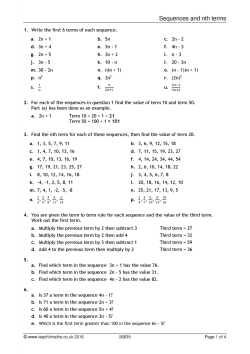Sequences and nth terms

The worksheet begins with substitution into an nth term to generate a sequence, progressing to finding an nth term and finishing with harder problems. Suitable for KS4 or upper KS3.
Example question
For each of the sequences in question 1 find the value of term 10 and term 50.
Part (a) has been done as an example.
a. 2n + 1
Term 10 = 20 + 1 = 21
Term 50 = 100 + 1 = 10
All reviews
Have you used this resource?
Review this resource12/02/2021
A great worksheet, it explores different aspects of finding the nth term and the term to term rule. I used for upper KS3, overall a great resource.
30/09/2019
Thank you for your comment. By registering, you can access all our pdf content for free.
01/04/2019
Why do you have to be a subscriber
26/03/2019
Why do you have to be a subscriber
26/03/2019
Great. I find it very useful
18/10/2018
This helped me a lot. Thank you for creating a paper like this.
Karla Bennett, I agree with you: this is more ks3 than ks5.
Thank You
Karla Bennett, I agree with you: this is more ks3 than ks5.
Thank You
29/03/2018
Thank you for this great resource. A good selection of questions too. :)
27/10/2016
Good variety of excercises.
24/10/2016
I think this is meant for KS3 or KS4 not KS5
30/09/2016
